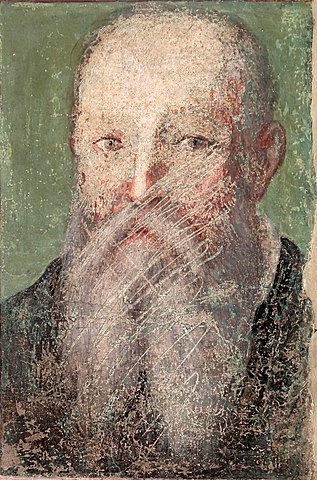
Born: 17 November 1503, Florence, Republic of Florence
Died: November 23 1572 (aged 69)
Period: Mannerism
The Life of Agnolo Bronzino
Agnolo Bronzino, born Agnolo di Cosimo di Mariano in 1503 in Monticelli, near Florence, Italy, was a leading Mannerist painter known for his sophisticated and elegant portraits that exemplified the cosmopolitan ideals of the Florentine court. His style is characterized by its refined elegance, cool color palette, and meticulous detail, making him one of the most prominent artists of the 16th century.
Bronzino’s early life was spent in Florence, where he was initially trained by Raffaellino del Garbo. His talent was soon recognized, and he became a pupil of Jacopo Pontormo, one of the early exponents of Mannerism. Under Pontormo’s guidance, Bronzino’s style flourished, and he developed a keen interest in portraying the human figure with elongated proportions and in complex, often twisted poses that are typical of Mannerist aesthetics.
By the 1530s, Bronzino’s reputation had grown significantly, leading to his introduction to the Medici court. His association with the Medici family, especially with Duke Cosimo I de’ Medici, was a turning point in his career. He became the court painter, a position that allowed him to work on a variety of projects, including portraits, religious subjects, and mythological scenes. Among his most notable works are the portraits of Cosimo I de’ Medici, Eleonora of Toledo, and other members of the Medici family, which are celebrated for their psychological depth and formal elegance.
Beyond portraiture, Bronzino was also involved in decorative schemes for the Medici palaces, where his frescoes and tapestry designs further demonstrated his versatility and command over different mediums. His religious and mythological compositions, such as “The Allegory of Happiness” and “The Martyrdom of St. Lawrence,” showcase his ability to imbue traditional themes with a new sense of drama and complexity, aligning with the Mannerist interest in artifice and the manipulation of space and form.
Bronzino’s influence extended beyond his immediate circle, as he played a significant role in the Florentine Academy, contributing to the intellectual and artistic debates of his time. His work in the academy emphasized the importance of drawing and disegno as the foundation of the arts, a principle that was central to Renaissance and Mannerist art theory.
Agnolo Bronzino died in Florence in 1572, leaving behind a legacy that cemented his place as one of the most important figures of the Mannerist movement. His artworks continue to be studied and admired for their technical precision, elegance, and the unique window they provide into the courtly life of Renaissance Florence.
Agnolo Bronzino’s Notable Works
Agnolo Bronzino, a prominent Mannerist painter from Florence, Italy, created numerous notable works during the 16th century. His art is renowned for its elegant portrayal of figures, meticulous detail, and the sophisticated use of color. Here are ten of Bronzino’s most famous works:
- An Allegory with Venus and Cupid (c. 1545) – Often considered one of Bronzino’s masterpieces, this complex painting is full of symbolic figures and has been interpreted in various ways. It’s celebrated for its intricate detail and emotional depth.
- Portrait of Eleonora of Toledo with her son Giovanni (c. 1545) – This painting is one of the most famous portraits of the Renaissance, showcasing the wife of Cosimo I de’ Medici, Duke of Florence. It’s admired for its sumptuous detail, including the elaborate dress and intricate jewelry.
- Portrait of Cosimo I de’ Medici (c. 1545) – As the Duke of Florence, Cosimo I’s portrait by Bronzino exudes power and authority. The meticulous detail in his armor and the subtle hints of his achievements make this a significant work.
- Portrait of Lucrezia Panciatichi (c. 1540) – This portrait is celebrated for its exquisite detail, including the texture of the fabric and the lifelike appearance of Lucrezia.
- Portrait of a Young Man with a Book (c. 1530s) – This work is often noted for its psychological depth and the intricate depiction of the young man’s attire.
- Saint Sebastian (c. 1533) – This painting depicts the martyrdom of Saint Sebastian in a manner that emphasizes his beauty and stoicism in the face of suffering.
- The Martyrdom of Saint Lawrence (c. 1565) – Bronzino’s portrayal of Saint Lawrence’s martyrdom is notable for its dramatic intensity and the use of light to highlight the saint’s expression.
- The Holy Family with Saint Anne and the Infant Saint John the Baptist (c. 1540) – This religious scene is appreciated for its intimate portrayal of the Holy Family, with detailed expressions and interactions between the figures.
- Portrait of Bartolomeo Panciatichi (c. 1540) – This portrait is a counterpart to that of Lucrezia Panciatichi, showcasing Bronzino’s skill in portraying male subjects with equal finesse.
- Allegory of Happiness (c. 1564) – Held in the Uffizi Gallery, this work is celebrated for its intricate allegorical symbolism and the serene beauty of its figures.
Bronzino’s legacy lies in his mastery of portraiture and his ability to convey the elegance and sophistication of the Florentine court. His works remain significant for their contribution to Mannerist art and their detailed depiction of 16th-century attire, personality, and power.